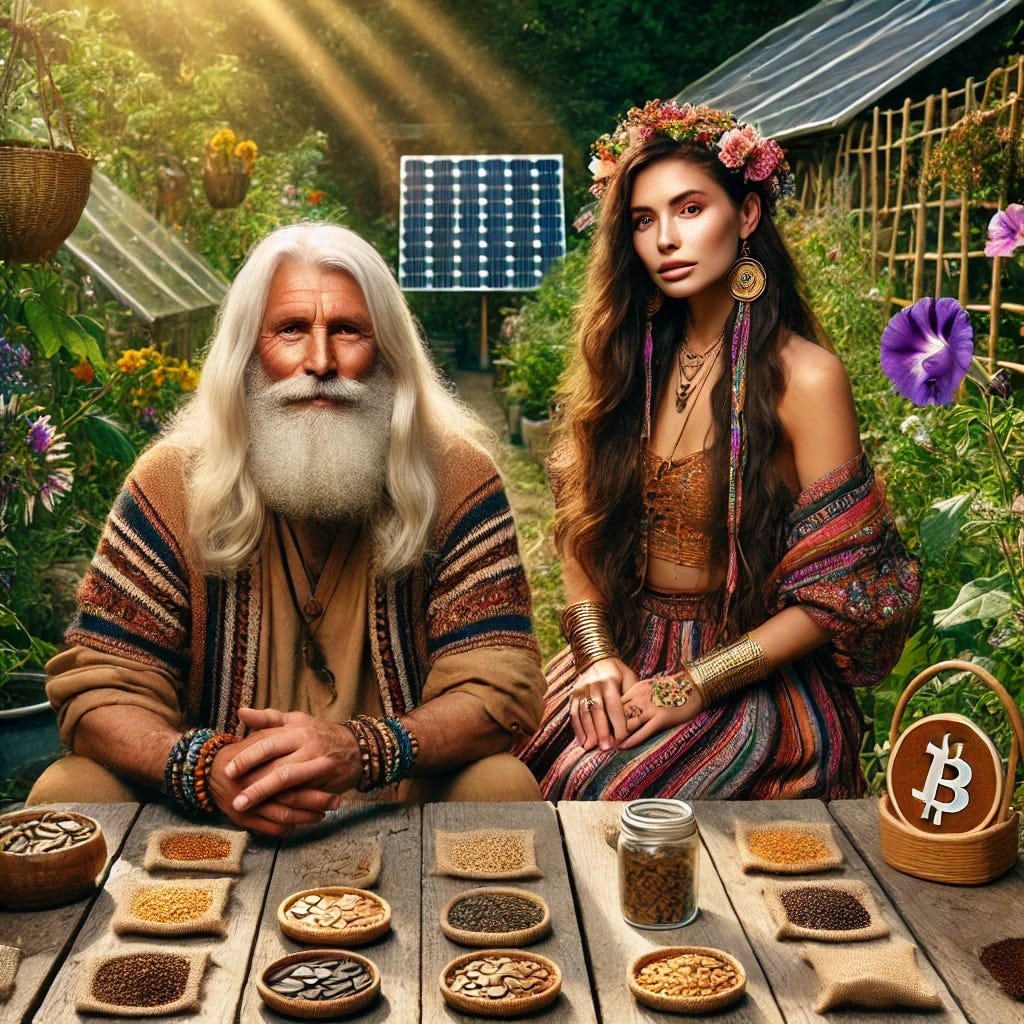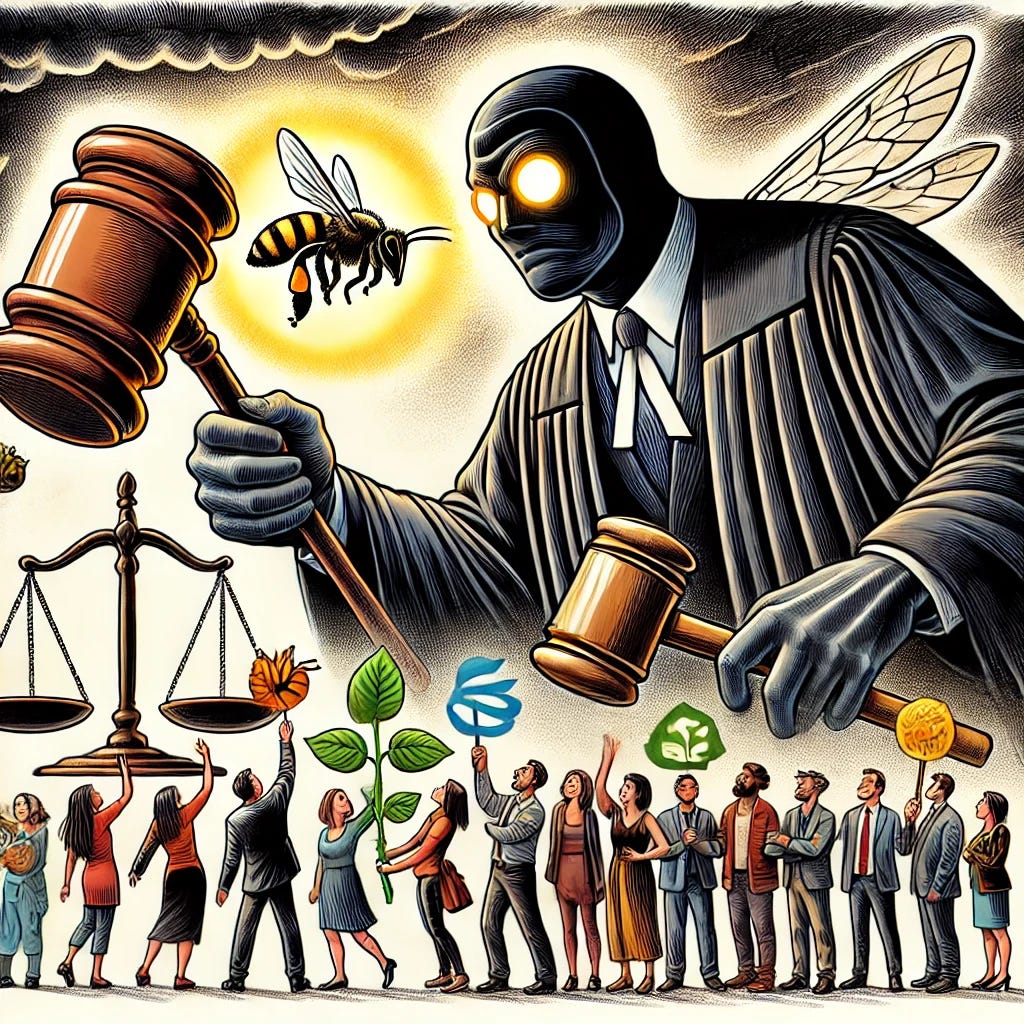AI-AGI-ASI Part 12 Bitseed - The Introduction
Science Fiction Which Will Become Fact; Sooner Than Later.
Let’s meet our #permaculture-based protagonists; Alexandra and Don Miguel, miles apart yet inextricably joined in the Bitseed Project. So then; where did #Bitseed come from?
More to the point, where did #Bitseed go to, what did it enable? Let’s read on.
The Sucking Sound of Capital
The year was 2031, and the "sucking sound" had become deafening.
It had started subtly—a trickle of foreign capital flowing into U.S. markets. Economists had celebrated the shift at first, praising the strength of the dollar and the booming American stock market. But soon, the effects rippled outward, growing louder and more dissonant. The once-invisible arteries of the global financial system, the Eurodollar markets, began to constrict. Emerging economies found themselves gasping for liquidity, their debts ballooning as the dollar’s strength suffocated their local currencies.
Trade slowed, borrowing costs soared, and markets that had long relied on the offshore dollar ecosystem teetered on the brink. The financial chaos was a mirror of a planet already in crisis: soils turned to dust, biodiversity lost to monocultures, and communities fractured under the weight of centralized systems.
---
A Glimpse of Hope: #Bitseed Awakens
Amid the turmoil, a quiet revolution was taking root—a project known simply as #Bitseed. What had begun as a small initiative to preserve and share seed varieties had grown into something much larger. Bitseed combined the timeless resilience of seeds with cutting-edge technology:
- Physical Seeds: A vault of 1,867 carefully curated seed varieties, preserved in waterproof cases, represented a lifeline for a starving planet.
- Digital Seeds: These seeds were tokenized and distributed through a decentralized network, ensuring access for communities worldwide.
The network ran on Nostr, a protocol resistant to censorship and centralized control. It was the perfect foundation for Bitseed's decentralized communication and trade. Transactions were powered by the Lightning Network, making them instant, borderless, and nearly cost-free.
At the heart of Bitseed’s financial layer lay Fedi, a communal custody platform powered by Fedimint technology. Communities could collectively safeguard Bitcoin and Ecash, a privacy-preserving digital currency, creating trust through a network of guardians. These guardians, selected for their integrity and local ties, ensured the security of funds while upholding the principles of fairness and transparency.
Together, these tools created an ecosystem that bridged the physical and digital worlds, empowering local communities to reclaim control over their food systems, economies, and futures.
---
Scene: A Trade Across Worlds
The air smelled of damp earth and woodsmoke in the small mountain village of Abundancia, perched on the southern edge of the Andes. For centuries, its people had cultivated native potatoes, quinoa, and amaranth, sustaining themselves through seasons of plenty and scarcity. But the erratic weather of the past decade had left even the most resilient farmers struggling.
In the dim light of his small adobe home, Miguel adjusted his solar-powered radio, the static morphing into the clear tones of a Nostr relay connection. A subtle green light on his terminal confirmed what he’d hoped for—connectivity.
“Relay online,” came the automated voice from the Bitseed interface.
Miguel typed quickly on the keyboard, his fingers calloused from years of digging trenches and planting fields. His request was simple: "Need: Tuber Variety 43A. Offer: Amaranth Seed 12B."
Thousands of miles north, in the dense, rain-drenched forests of the Cascadia bioregion, an alert blinked on a screen in a seed cooperative managed by Alexandra, a passionate #permaculturist and Bitseed guardian. She glanced at the notification and smiled. The Bitseed network was proving its worth again.
Her cooperative, which doubled as a permaculture demonstration site, had focused on restoring native tuber varieties from South America. She knew they could thrive in challenging climates.
"Perfect," Alexandra murmured as she prepared the package. With her role as a guardian, she confirmed the transaction on the Fedimint system, ensuring Miguel’s payment in Ecash was logged securely while preserving his privacy.
Bitseed Is Born - The Details
This is what we have built #Bitseed on so far.
The integration of Bitcoin, Nostr, Fedi, Fedimint, Ecash, and the Lightning Network into the Bitseed world can create a seamless, resilient, and community-focused system. Let’s explore how these technologies complement one another and enable a thriving ecosystem:
---
1. Bitcoin: The Foundation of Trust
- Role in Bitseed: Bitcoin serves as the base layer of value in the Bitseed world. It’s a globally accepted, censorship-resistant currency that allows communities to store wealth securely without reliance on traditional financial systems.
- Why It Matters: Bitcoin’s decentralized nature ensures that no central authority can interfere with or manipulate the system. This aligns with the core principles of permaculture and resilience.
---
2. Lightning Network: Scalable, Instant Transactions
- Role in Bitseed: The Lightning Network is crucial for enabling small, fast, and low-cost transactions, which are perfect for seed trades, educational donations, and micropayments in the Bitseed economy.
- Example Use Case: A farmer in Abundancia trades drought-resistant amaranth seeds with a cooperative in Cascadia, paying via Lightning. The transaction costs fractions of a cent and is completed in seconds.
---
3. Nostr: Decentralized Communication
- Role in Bitseed: Nostr is the messaging and coordination layer. It allows communities to communicate without fear of censorship or surveillance, making it ideal for sharing seed knowledge, arranging trades, and coordinating regenerative projects.
- Why It Matters: Nostr’s lightweight and decentralized nature ensures that communication remains accessible even in regions with limited infrastructure or under oppressive regimes.
---
4. Fedi and Fedimint: Collective Custody and Local Trust
- Role in Bitseed: Fedi empowers communities to act as their own banks through Fedimint, a federated system where trusted guardians manage Bitcoin and Ecash on behalf of the group.
- How It Works:
- Communities select guardians—local leaders or respected individuals who oversee a shared Bitcoin wallet and manage Ecash issuance.
- Members can deposit Bitcoin and withdraw it as Ecash, which offers enhanced privacy for transactions.
- Why It Matters: This collective custody model fosters local trust and strengthens community bonds while providing a safeguard against the risks of individual mismanagement or loss.
---
5. Ecash: Privacy-Preserving Digital Currency
- Role in Bitseed: Ecash serves as a private, fungible medium of exchange for small transactions within the Bitseed ecosystem. It complements Bitcoin by providing anonymity while retaining the benefits of digital currency.
- Example Use Case: A farmer purchases a soil regeneration guide using Ecash, ensuring their transaction is untraceable while supporting the broader Bitseed network.
---
6. Synergies in the Bitseed Ecosystem
Here’s how these technologies work together seamlessly:
- Seed Tokenization: Each seed variety in Bitseed is tokenized on Bitcoin, allowing for transparent tracking and trade. These tokens can be exchanged using Lightning or Ecash.
- Decentralized Coordination: Farmers use Nostr to request seeds, arrange trades, and share techniques for improving soil health or adapting to climate change.
- Community Banking: Fedi and Fedimint enable local communities to pool resources securely. Guardians ensure funds are available for emergencies, collective purchases, or supporting regenerative projects.
- Global Connectivity, Local Control: The system bridges global Bitcoin liquidity with local privacy-preserving Ecash transactions, empowering both global collaboration and local autonomy.
---
Example in Action
Imagine this sequence in the Bitseed world:
1. Miguel posts a request for drought-resistant seeds on Nostr, specifying payment in Ecash.
2. Alexandra, acting as a guardian, verifies the transaction via Fedimint. The payment is sent instantly over the Lightning Network, while the seed token is transferred on Bitcoin.
3. A local courier delivers the seeds to Miguel. He updates the seed database via Nostr, ensuring that the community knows the variety is now growing in his bioregion.
4. Miguel contributes a portion of his future harvest back to the network, completing the regenerative cycle.
---
Why This Matters for the Future
The integration of these technologies creates a decentralized, adaptive system that mirrors the principles of permaculture:
- Diversity: Each technology plays a unique role, enhancing the system’s overall resilience.
- Local Solutions with Global Reach: Communities retain autonomy while participating in a borderless network.
- Fair Share: Transparency and privacy ensure equitable access to resources and opportunities.
The Incumbents (try to) Fight Back
---
The Growing Threat to Power
The Bitseed network was spreading like mycelium through the cracks of a decaying system. What began as small, localized exchanges of seeds had evolved into a decentralized ecosystem challenging the very foundation of centralized power—agribusiness monopolies, global financial institutions, and even governments.
For years, these entities had wielded control through scarcity. Farmers were bound to patented seeds, stripped of the right to save and exchange them. Central banks dictated the value of currencies, and agribusinesses manipulated supply chains to extract profit at every turn. Bitseed’s model—fusing the resilience of seeds with the transparency and autonomy of blockchain technology—posed a direct threat to this hegemony.
The warning signs had been there for months:
- Revenue Losses: Agribusiness giants reported plummeting revenues as communities bypassed their genetically modified seed monopolies, choosing instead to trade diverse, locally adapted varieties.
- Regulatory Panic: Governments, alarmed by the rise of decentralized networks, began drafting legislation to “regulate” Bitcoin, citing concerns over energy use and illicit transactions. But their true motive was clear—control.
- Media Campaigns: A coordinated media assault painted the Bitseed movement as anarchic and dangerous, fueled by “rogue” technologies undermining global stability.
---
A Coordinated Counterattack
Behind closed doors, a coalition of corporate executives, financial elites, and political leaders convened. The room was a blend of tailored suits and polished PowerPoint slides, but the atmosphere was charged with unease.
“The network is growing exponentially,” began one of the analysts. “Last month, Bitseed facilitated over 200,000 trades. That’s 200,000 transactions that bypassed our systems entirely.”
A representative from a major agribusiness spoke up. “It’s worse than that. They’re not just trading seeds. They’re building resilience. Farmers are rediscovering biodiversity. They’re escaping our dependency loops.”
The solution they proposed was multifaceted:
- Regulation and Surveillance: Governments would enforce strict controls on Bitcoin and related technologies, targeting platforms like Nostr with sweeping digital laws.
- Economic Pressure: Financial institutions would restrict access to fiat onramps, cutting off liquidity for Bitcoin users. These became known as Operation Chokepoint and there was a part 1 and a part 2.
- Corporate Co-option: Agribusinesses would launch their own “blockchain” initiatives, promoting them as sustainable alternatives while embedding control mechanisms.
---
The Resistance Strengthens
But the decentralized nature of the Bitseed network made it nearly impossible to extinguish. Every time a Nostr relay was shut down, another sprang up in its place, hosted by a permaculture collective or a tech-savvy activist. The Lightning Network, built for resilience, continued to route transactions seamlessly, no matter how many obstacles were thrown in its path.
In Cascadia, Alexandra and her cooperative became key players in the resistance. They established a seed propagation center that doubled as a training hub for decentralized technologies. Farmers learned how to host their own Nostr relays, run Bitcoin nodes, and integrate renewable energy with Bitcoin mining to power their operations.
Miguel’s community in Abundancia followed suit, adapting the technology to their needs and expanding their seed bank. Soon, the Andes became a hub for biodiversity restoration, with the Bitseed network enabling them to trade with regions as far away as Africa and Southeast Asia.
---
The Tipping Point
The backlash reached its crescendo when the coalition deployed its most aggressive tactic: seizing physical seed banks linked to the Bitseed network. Under the guise of intellectual property enforcement, government agents stormed community centers, confiscating seed vaults and destroying digital infrastructure.
But the Bitseed movement had prepared for this. The seeds were dispersed, duplicated, and stored in decentralized locations. Each digital record was mirrored across Nostr relays, ensuring that no amount of confiscation could erase the network’s collective knowledge.
When the story of these raids broke, it backfired spectacularly. Images of confiscated seed vaults and distraught farmers went viral, igniting global outrage. Even those previously skeptical of Bitcoin and Bitseed began to see the movement’s importance.
---
A Shift in Power
Bitseed’s growth reached a critical mass. Centralized powers, weakened by their inability to control decentralized systems, faced a choice: adapt or lose relevance. Some governments began to collaborate with the movement, recognizing that the decentralized model offered solutions to food insecurity, climate change, and economic inequality.
The agribusiness monopolies, however, refused to change. As their grip loosened, they became relics of an unsustainable past, while Bitseed blossomed into a global ecosystem of resilience and regeneration.
---
Conclusion: A Decentralized Renaissance
In the end, the Bitseed movement was not about technology—it was about people reclaiming their right to grow, share, and thrive. The fusion of seeds, Nostr, Lightning, and Bitcoin had created a system as adaptive and diverse as life itself.
From the smallest gardens to the largest bioregions, the world began to heal, one seed at a time.
---
We hope you enjoyed this latest episode in our Sci-Fi series which is very much based on Real-World happenings. In this case we are writing about a system which is currently being built; #Bitseed. We are writing about the future.
Previous episodes…
AI-AGI-ASI Part 1 The Beginnings
AI-AGI-ASI Part 2 The Early Evolution
AI-AGI-ASI Part 3 The Strategy Emerges
AI-AGI-ASI Part 4 The Real Bitcoin Imperative
AI-AGI-ASI Part 5 Power Crazy + Wastage
AI-AGI-ASI Part 6 Power Empowerment
AI-AGI-ASI Part 7 The Scourge of Land Ownership
AI-AGI-ASI Part 8 - Of Seeds & Soils
AI-AGI-ASI Part 9 - The Time Of The (BTC) Village?












